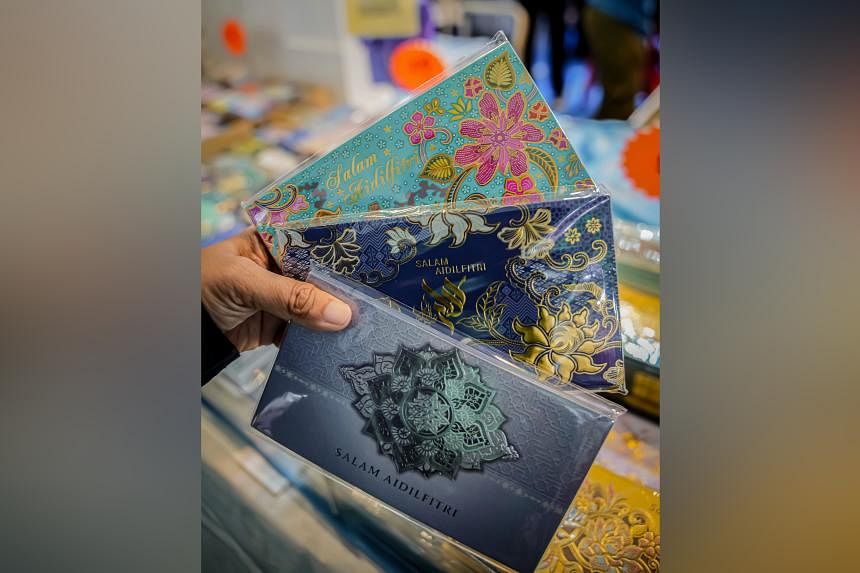PETALING JAYA - Physical banknotes are the preferred choice for many Muslims in Malaysia when it comes to giving duit raya, but online cash transfers are gaining ground as an alternative.
The custom of handing out packets containing money as gifts to family and other loved ones, especially children, during Hari Raya Aidilfitri, is seen as a way to strengthen ties and ease the burden of the needy.
Ms Rafiqha Mustaffa, 32, is among those who prefer the traditional method of giving out duit raya in the form of physical banknotes.
“I give my children duit raya in cash for sentimental reasons. I remember feeling happy when I received the cash in my hand, so I want my children and other children to experience the same,” said the mother of two.
Others, such as Ms Ashikin Azhar, prefer cashless transactions for convenience.
“Digital money transfers are very appealing to me as they are easier and immediate, and nowadays, there are many banks and financial institutions that offer e-duit raya transfers,” she said.
Ms Ashikin, who works as a sales manager, said money transfers can be accompanied by digital greetings or personalised messages that add a personal touch to the tradition.
Let’s get physical
For example, in March 2023 when Ramadan was observed, the circulation of RM1 notes rose by 7.25 per cent month on month to RM3.34 billion (S$947 million).
The figure went up further to RM3.46 billion in April 2023, which was when Aidilfitri was celebrated.
The circulation of RM5 notes grew by 7.51 per cent in March to RM3.33 billion, and to RM3.44 billion in April 2023.
Among the ringgit’s denominations, the RM1 and RM5 notes recorded the biggest increase in the number of banknotes in circulation during Ramadan and Aidilfitri.
A gradual digital shift
The central bank’s payment statistics also show a significant year-on-year increase in e-money transactions.
Transaction value of e-money in 2023 stood at RM106.7 billion, with a total of 4.02 billion transactions.
The value of e-money transactions – comprising fund transfers and mobile remittances – went up nearly 50 per cent from RM71.18 billion in 2022.
According to Bank Negara’s 2023 annual report, 59 per cent of e-money transactions stemmed from e-wallet usage and the remainder from card-based e-money.
Amid the overall increase over the past few years in e-money transactions, the central bank’s figures reveal a spike during Aidilfitri.
The month-long Aidilfitri celebration from April to May in 2023, for example, showed a clear uptick, with the volume of e-money transactions rising 10.4 per cent month on month in May to 331.9 million transactions.
The value of transactions meanwhile went up by 7.47 per cent in May 2023 to RM8.35 billion.
Fintech company TNG Digital (TNGD) said it expects its cashless convenience and seamless payment features to give its Money Packet transactions a boost in 2024.
TNGD is expecting a 250 per cent increase in total Money Packet value sent and claimed by users.
Money Packet is a feature on TNGD’s app that allows users to transfer credit to friends and family, up to 100 people, either in random or equal value.
The company also said it was expecting a 40 per cent increase in total Money Packet users and a 180 per cent increase in the total quantity of Money Packets created.
In 2023, TNGD introduced an “equal distribution” option in the TNG e-Wallet Money Packet feature, just before Raya.
This option allows users to send an equal amount in money packets to friends and relatives.
“We then observed a close to 41 per cent increase in the daily number of Money Packet creators.
“Throughout the festive season last year, we accumulated almost one million Money Packet users,” the company said.
Based on data from 2023, TNGD said more than 80 per cent of users who engaged in sending TNG e-Wallet Money Packet as e-duit raya were Malays, and among them, 70 per cent were existing loyal users.
TNGD said the current trend was consistent with its effort to help minimise waste and tackle challenges that arise due to limited access to new banknotes and banking services in certain areas.
“However, it is important to note that this digital trend may not entirely replace traditional practices.
“We want to make the act of giving and receiving e-duit raya more delightful and interesting for all users involved,” it said. THE STAR/ ASIA NEWS NETWORK

